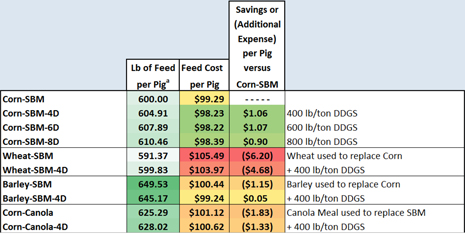
What are the alternatives to expensive corn and soybean meal?
 By Dr. Dean Koehler
By Dr. Dean Koehler
Widespread drought conditions are heightening concerns among swine producers regarding the high cost – and potentially short future availability – of corn and soybean meal. An old economics adage reminds us that “a rising tide lifts all boats.” In the Midwest, corn and soybeans are king. Changes in their prices affect the prices of all other grains and feed proteins. High corn costs might also decrease the availability, and increase the cost, of DDGS if lower ethanol profits cause plants to decrease ethanol and, thereby, DDGS production. Fortunately, hogs do not have a requirement for corn or soybean meal, so certainly other feedstuffs can be used to formulate nutritionally adequate swine diets. However, as the costs of corn and soybean meal increase, so do the costs of potential alternatives to these two staple feedstuffs. And many alternative ingredients have inherent additional hurdles for swine producers in the form of issues with availability, handling and transportation costs of the new ingredients. Following are some of the ingredients that can potentially reduce corn and soybean meal inclusions in swine diets, or replace them altogether:
- Wheat
- Barley
- Bakery product
- Wheat midds
- DDGS
- Canola meal
- Meat and bone meal
This list of nutrition alternatives is not short, so how do you decide which products make the most economic sense for your operation? In today’s volatile markets, how do you know if decisions you made a month ago are still the best choice? No doubt, assessing current ingredient costs can spiral into a big project in a short amount of time. That’s where your nutritionist can play a helpful role. The Vita Plus swine nutrition team has developed a new Nutrition Alternatives Calculator (previewed in Table 1 below) that can be used to evaluate the economics of all of these potential alternative ingredients in grow-finish swine diets. Based on current prices, we can help you determine which combination of ingredients makes the most economic sense for your nutrition program. Contact your Vita Plus swine consultant to learn more about this new tool or to have economic comparisons prepared for your own specific situation. Table 1. Vita Plus Nutrition Alternatives Calculator  About the author: Dr. Dean Koehler has served as swine technical services manager since joining Vita Plus in 2001. He was raised in southwest Minnesota and was active in 4-H and FFA. His youth livestock projects included raising and showing swine and sheep. Koehler earned his bachelor’s degree in animal science and his master’s degree and Ph.D. in swine nutrition from the University of Minnesota. His master’s research investigated the digestibility of raw soybean varieties naturally low in anti-nutritional factors when fed to growing pigs. His doctorate research utilized a stable isotope of the amino acid lysine to measure how efficiently sows transfer dietary lysine into their milk. Koehler is interested in all facets of swine nutrition. His role at Vita Plus is to provide technical service to the field and supervise the development of support tools, such as technical bulletins and spreadsheets. Additionally, he is the author the Vita Plus online grow-finish feed budgeting software, mentor.
About the author: Dr. Dean Koehler has served as swine technical services manager since joining Vita Plus in 2001. He was raised in southwest Minnesota and was active in 4-H and FFA. His youth livestock projects included raising and showing swine and sheep. Koehler earned his bachelor’s degree in animal science and his master’s degree and Ph.D. in swine nutrition from the University of Minnesota. His master’s research investigated the digestibility of raw soybean varieties naturally low in anti-nutritional factors when fed to growing pigs. His doctorate research utilized a stable isotope of the amino acid lysine to measure how efficiently sows transfer dietary lysine into their milk. Koehler is interested in all facets of swine nutrition. His role at Vita Plus is to provide technical service to the field and supervise the development of support tools, such as technical bulletins and spreadsheets. Additionally, he is the author the Vita Plus online grow-finish feed budgeting software, mentor.
| Category: |
Corn and soybeans Feed costs Feed quality and nutrition Swine Performance |

